Originally Published on September 21, 2023. Last Updated on September 22, 2023.
To successfully select a table for your deck or terrace, it helps to know what you want and how to find it. It may sound simple, but these notions are always easier said than done.
We decided to create a comprehensive patio table size guide you can use to learn everything you need to know about these outdoor essentials. Our guide contains detailed information about table sizes, shapes, and types; the best methods for measuring your space; product suggestions based on your lifestyle needs; style advice; and much more.
Jump to Section
Why Size Matters
Measure Your Space
Tips for Choosing the Right Size
Dining Table Shapes & Sizes
Accent Table Types, Shapes & Sizes
Table Recommendations
Balancing Size & Aesthetic
FAQs
Why Is the Right Patio Table Size Important?
Picking the right table size matters because it needs to be scaled proportionally to your deck space. An oversized table won’t physically fit into the space, or it leaves barely enough room for guests to skirt by. On the other hand, a table that’s too small feels incongruous in an ample area. Plus, it won’t keep up with your entertaining needs.
How To Measure Your Space for a Patio Table
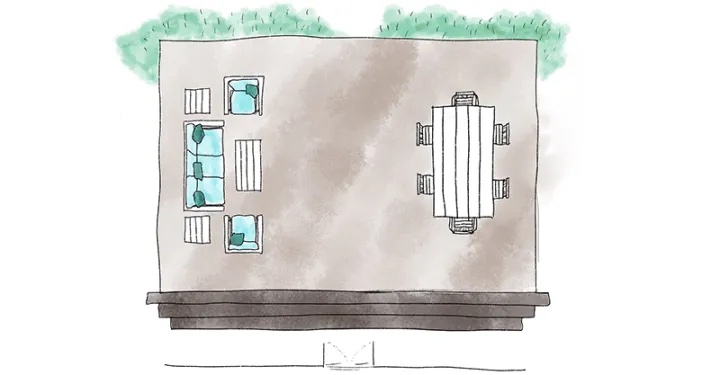
Your setting’s shape and size dictate the type of table you should buy. Follow these steps to determine how much usable space you have.
- Find the length and width of your space using a tape measure, and multiply those numbers to get the square footage.
- If there’s furniture in the room, find the area of each piece with your tape measure, then subtract those dimensions from the room’s square footage. The final figure is open space.
- Ensure existing open space is unoccupied. For safety and style reasons, tables should not block doorways, stairs, or walkways.
Tips for Choosing the Right Size Table
Follow our advice to choose the proper size table for your outdoor space.
- Ensure at least three feet of clearance on all sides of a dining table to give guests room to walk by and pull out their chairs.
- If you’d rather mix and match outdoor furniture instead of selecting a preconfigured set, plan for 10 to 13 inches between the underside of the table and the top of the seats. This allows plenty of legroom, preventing unwanted pressure on family members’ knees and thighs.
- Your dining table needs to provide two feet of space (from shoulder to shoulder) for each guest and at least 15 inches of depth in front of them to accommodate their place setting.
Understanding Different Outdoor Dining Table Shapes & Sizes

A dining table is where family gathers to eat. One size does not fit all, so we’ve broken down the technical details of the most common sizes and shapes.
Table Heights
These pieces come in three heights: dining, counter, and bar.
Dining Table Shapes
Round
Round tables are fantastic focal points because the human eye is naturally attracted to circular shapes. The lack of corners allows you to sneak in another seat or two if you need room for extra guests (though it will be a tight fit).
Square
The versatility of square tables allows them to fit small and large spaces. You can push them against the wall or corner in cozy areas when you need room for after-meal activities. Plus, the sides are equidistant, so anyone at the table feels included in the conversation. Larger styles can seat a crowd and look right at home on sprawling decks.
Rectangle
Rectangular tables can also fit in corners and along walls to save space, but their shape is better suited for bigger rooms. These designs have a leg-up on larger square styles. For example, an eight-person rectangular table takes up less floor space than a square eight-seat table, yet it can still accommodate everyone and the meal.
Oval
An oval table has an elongated shape that combines rectangular and round. Featuring a softer aesthetic than its rectangle cousin, the oval table still offers plenty of space for medium and large groups. However, the oval dining table length prevents it from being a good fit for smaller spaces.
Table Size
This list shows the average tabletop depth for dining-, counter-, and bar-height tables.
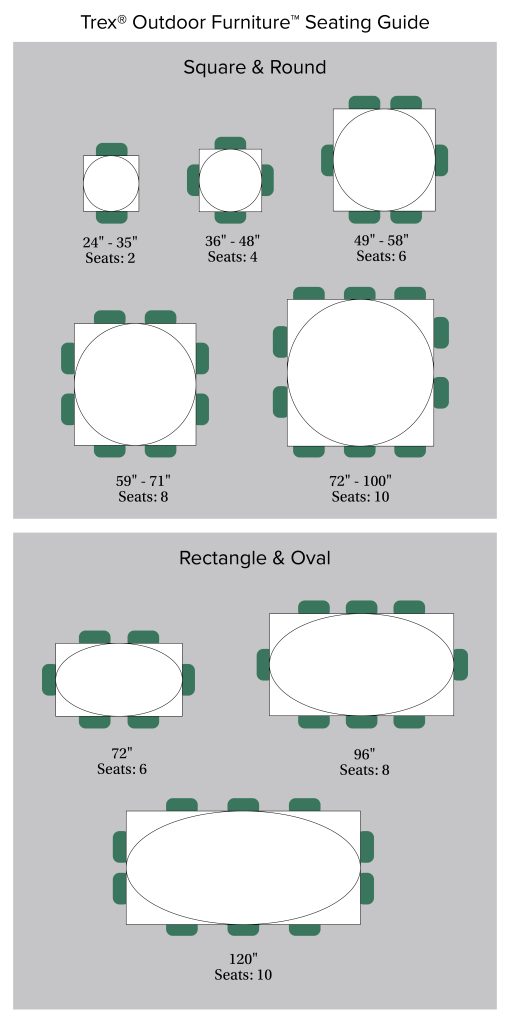
Outdoor Accent Table Types, Shapes & Sizes
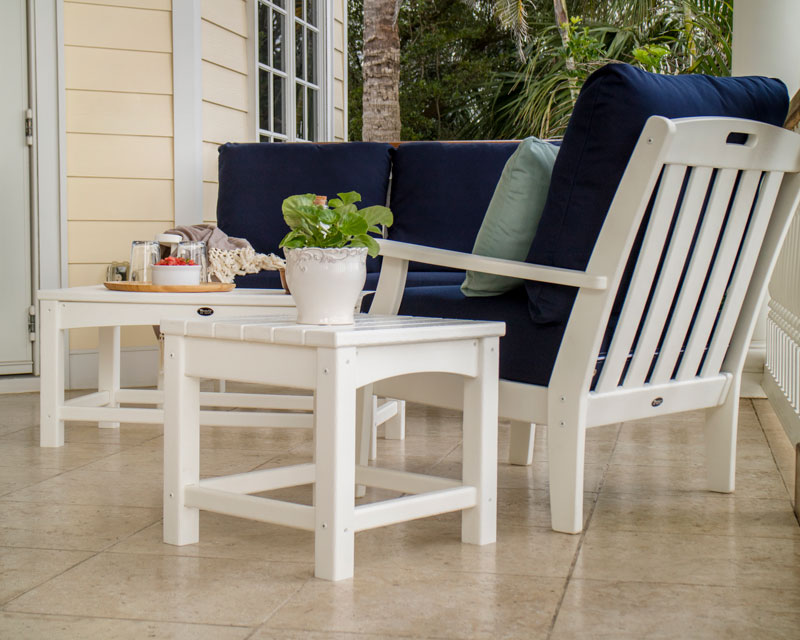
An accent table is a broad category that covers any small table that enhances the functionality and aesthetic of a patio space or seating arrangement. We parsed the particulars of the most standard designs below.
Table Type
Browse this list to learn about the different types of accent tables.
- Side table: Side tables are small and typically positioned against walls, to the side of a room, or next to seating.
- End table: An end table sits beside a sofa, sectional, or other large pieces of furniture, and its height is equal to the seat’s armrest.
- Coffee table: Coffee tables stand before sofas and feature short frames.
- Conversation table: Conversation tables are styled in the centers of lounge sets.
- Console table: Console tables have tall, narrow frames that line sofa backs or walls.
- Fire pit table: Fire pit tables feature built-in propane or natural gas burners at the center of their tabletops.
Table Size
Here is a list of the average dimensional ranges for various accent tables:


Table Recommendations Based on Space Size, Setting Type & Outdoor Activity
Space Size
- Small: Narrow balconies or cozy apartment patios need furniture that adds comfort without swallowing the space. We recommend small side and end tables to hold decor and drinks, or a square four-seat dining set that can be pushed against the wall with the chairs offering places to sit elsewhere.
- Medium: With more room to spare, a medium-sized patio is ideal for a grouping of lounge furniture with complementing conversation table mixed in to enhance the form and functionality.
- Large: A sprawling deck calls for a deep seating sectional. Try bookending your sectional with a pair of end tables and a coffee table at the center to get the best of comfort and convenience.
- Extra-large: Spaces this generous should be split into multiple areas. You can turn one portion into a meal space with a 7-piece dining set at the center to meet your alfresco aspirations. Then style a relaxing conversation space mere steps away filled with a deep seating set where a sofa and patio chair duo are flanked by end tables ready to hold after-dinner cocktails.
Setting Type
- Front porch: Sidle up a couple of side tables next to your rocking chairs so family has convenient drink rests for tall glasses of lemonade.
- Back balcony deck: Try a tall bar set so you can enjoy an uninterrupted view of the sunset over the lake.
- Rooftop sundeck: A dining set topped with a patio umbrella shades your family during Sunday brunch, which you can easily close at night to take in the starlit sky during dinner.
- Garden patio: Choose side or end tables to pull double duty as drink holders and plant stands so you can bring nature onto your patio.
Outdoor Activity
- Reading: An end table standing next to your deep seating chair and ottoman is all you need to enhance this small space. This table will patiently hold your phone, a bowl of trail mix, and an outdoor lamp while you thumb through this month’s issue from your favorite magazine subscription.
- Dinner party: You need ample space to seat everyone and serve the meal, so go with a spacious square or rectangle dining set that accommodates a crowd.
- Working from home: A small square table that can line the wall over an outlet will serve you well. You’ll have room for your laptop (near a power source), files, notepads, and your second cup of coffee.
- Cocktail hour: Secure a tall pub table that matches the height of your outdoor bar. This extends the serving space as well as seating space, so feel free to buy a few extra bar stools.
Maintaining the Balance Between Size & Aesthetic
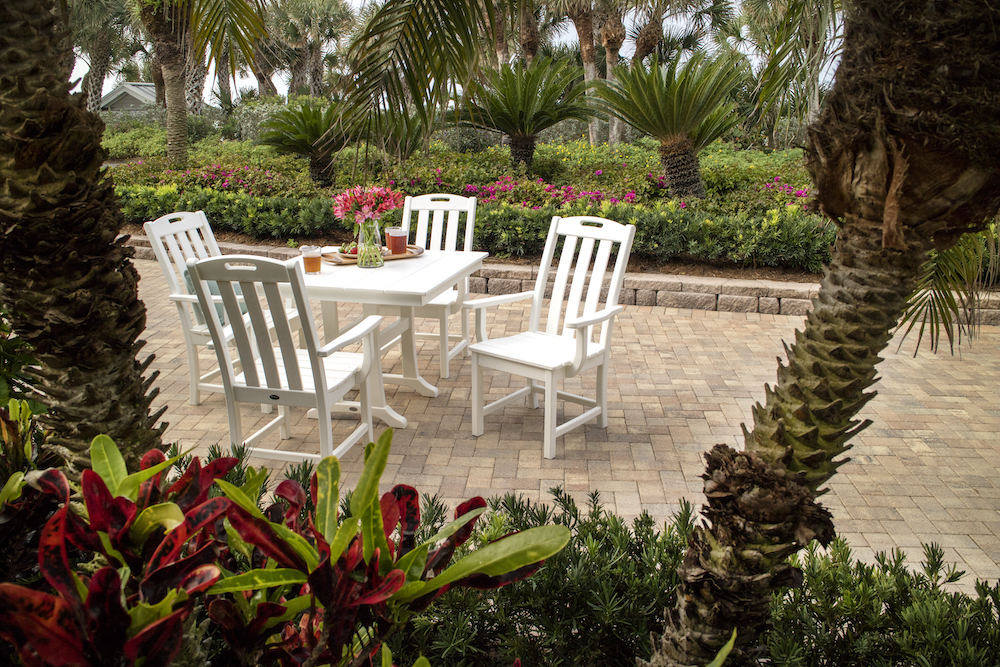
Balance is an important part of decorating as it creates cohesion, not letting one element overpower another. Use these tips to ensure the table you choose lives in harmony with your space.
Symmetry
Symmetrical balance creates order. Choose a pair of twin tables and style them in the same way on opposite sides of a room. For example, a duo of side tables sitting next to matching Adirondack chairs is a good starting point.
Asymmetry
Asymmetrical balance has a more eclectic bent that gives you creative freedom with styling. Use an odd number of pieces—such as a loveseat, two chairs, a coffee table, and an end table—and arrange them in a way that flows with your space. Choose outdoor furniture in the same color or design style to allow for visual continuity.
Radial Symmetry
Radial symmetry uses round objects and a main focal point to create balance. Try styling a round 5-piece dining set in the middle of your breakfast nook, with circular side tables on the perimeters holding pots of marigolds or dianthus.
60-30-10 Rule
This rule pertains to color. The main shade of your room’s color scheme should appear in 60% of the space, accent colors take up 30%, with the remaining 10% showing up in the decor. A deck balcony with white decking and railings, topped with hunter-green Adirondacks flanking a side table, and tall white planters sporting yellow pansies makes use of this rule.
Varying Heights
Choosing tables of differing heights creates a balanced design by distributing the visual weight in the room. A low-sitting fire pit table at the center of the room surrounded by tall bistro tables not only looks appealing but also gives guests places to set their drinks while they warm their hands near the glowing flames.
Avoid Empty Space
Don’t style everything in one corner and leave the rest of the room bare. Spread out your furniture and evenly distribute it around the setting.
FAQs
What are the most popular table sizes?
The most popular table sizes are rectangular, measuring at least 36 inches wide and 72 inches long. This table offers room for six people and fits a variety of spaces—a good fit for growing families and social couples who love to entertain.
What shape table takes up the least space?
A round table takes up the least amount of space. Its lack of corners gives it a smaller footprint than square or rectangle designs, while simultaneously allowing the freedom to bring in another seat.
What table makes a room look bigger?
Go for round tables to make a room look bigger. Round dining sets take up less room but let you squeeze in extra chairs. A circular conversation table sits low to the ground taking up less horizontal and vertical space.

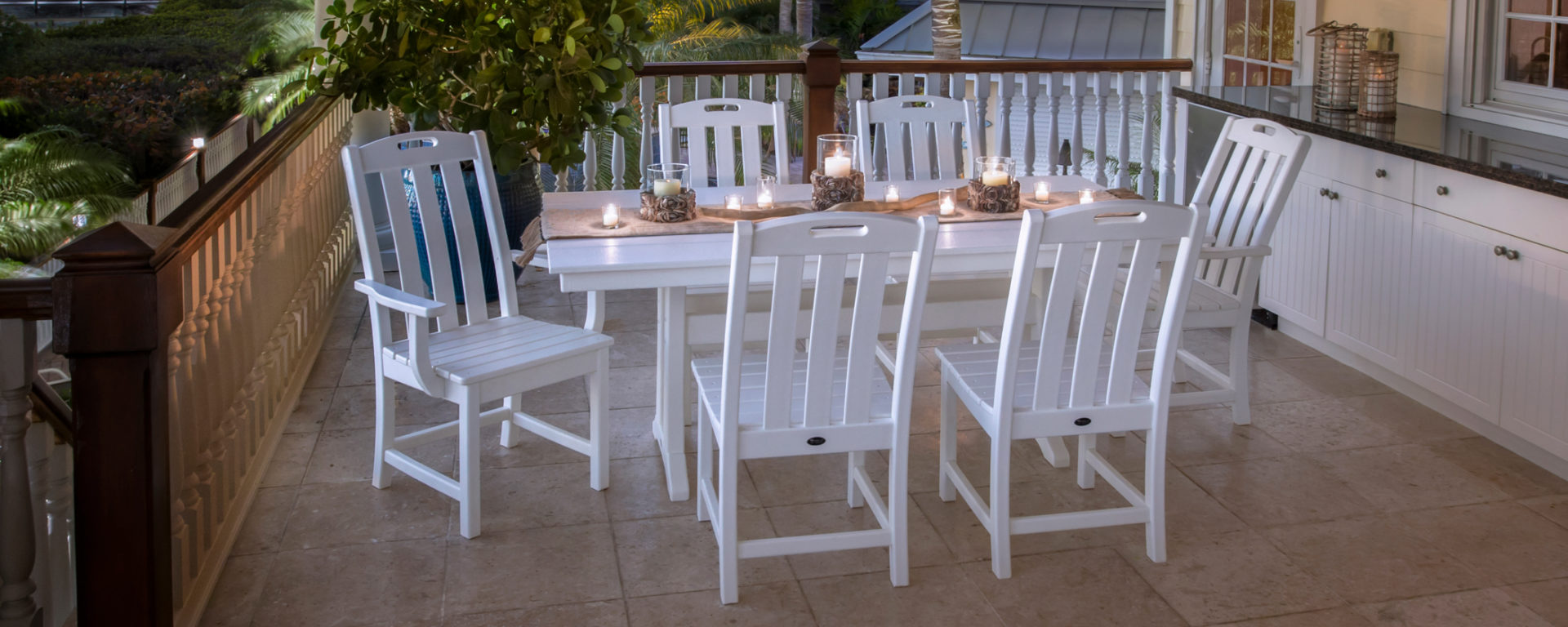
This patio table size guide is an invaluable resource for anyone looking to enhance their outdoor space. The comprehensive coverage of table sizes, shapes, and types, along with measuring tips and product recommendations, makes it a one-stop destination for informed decision-making. Kudos for simplifying a seemingly daunting task and providing clarity on selecting the perfect table for our decks and terraces. This guide is a game-changer!